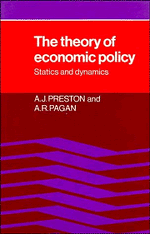Book contents
- Frontmatter
- Contents
- Preface
- Part I The static theory of policy
- 1 A review of the static theory of policy
- 2 The algebraic structure of fixed objective problems
- 3 The algebraic structure of flexible objective problems
- Part II Dynamic fixed objectives: on hitting points and paths
- Part III Dynamic flexible objectives: on tracking points and paths
- References
- Index
3 - The algebraic structure of flexible objective problems
Published online by Cambridge University Press: 05 November 2011
- Frontmatter
- Contents
- Preface
- Part I The static theory of policy
- 1 A review of the static theory of policy
- 2 The algebraic structure of fixed objective problems
- 3 The algebraic structure of flexible objective problems
- Part II Dynamic fixed objectives: on hitting points and paths
- Part III Dynamic flexible objectives: on tracking points and paths
- References
- Index
Summary
Introduction
Under the conventional assumption of quadratic preferences, the flexible objective problem generates first-order conditions constituting a linear system – so bringing the analysis of the flexible objective problem closer to the analysis of the fixed objective problem than might otherwise appear.This correspondence of the fixed and flexible analyses induced by linearity is the central preoccupation of Chapter 3.
A heuristic explanation will help motivate the essential unity of the fixed and flexible objective approaches. A policymaker poses a fixed objective problem. Using the analyses of Chapters 1 and 2, he determines that global policy existence fails; and additionally that local policy existence in some neighbourhood of a specific fixed objective also fails. Accordingly, he specifies a quadratic loss metric centred on the desired, but unattainable, fixed objective, and minimises this to get as close to the desired fixed objective as the policy model constraint permits. In fact (recall Figure 1.4) with quadratic preferences, the ‘closest’ feasible fixed objective is a projection of the desired fixed objective onto the range space of the fixed objective policy model mapping. In particular, if the policymaker's preferences are neutral with respect to individual fixed objectives (that is, loss contours are circular, as in Figure 1.4), the ‘best’ or ‘closest’ feasible fixed objective is actually the orthogonal projection of the desired fixed objective onto the feasible objective space.
Information
- Type
- Chapter
- Information
- The Theory of Economic PolicyStatics and Dynamics, pp. 84 - 120Publisher: Cambridge University PressPrint publication year: 1982
